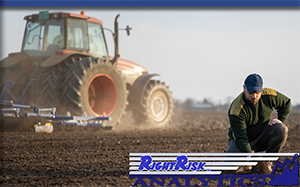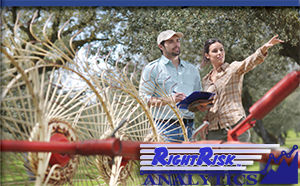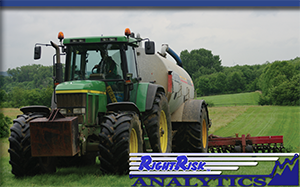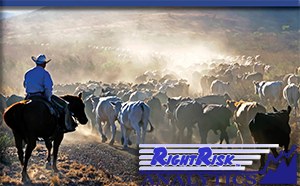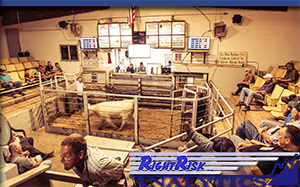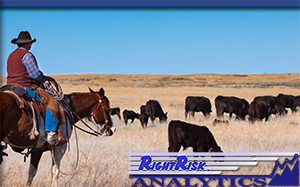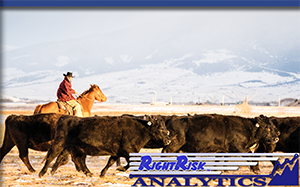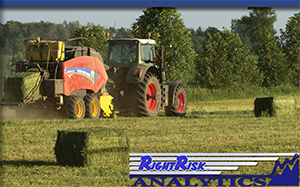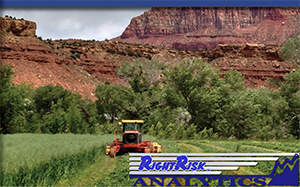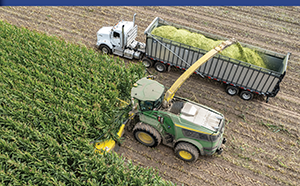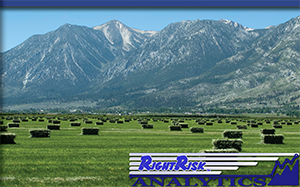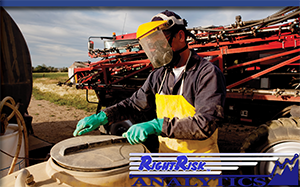 | |
Applied Risk Analytics |
|
|
|
Evaluating Windrower Options with |
|
|
|
Comparing Conventional and Strip-till Tillage Systems Brothers Ken and Rich Riff own and operate a row crop operation situated in Big Horn County, Wyoming. Currently the Riffs are considering converting the tillage portion in their operation from conventional tillage (using a disk harrow and moldboard plow) to a strip-till system (a more minimum-tillage approach). The Riffs like the idea of reducing the number of tillage passes, especially with high fuel costs, as well as the conservation benefits such as reducing erosion and crop water needs. They would like to examine the per acre costs of switching to a strip-till system, as well as look at the potential long-term benefits and costs associated with making a change. The Riff Brothers need to compare the operating costs of the two tillage systems. The Machine Risk Calculator (MRC) was developed to calculate overall machinery costs. |
|
|
|
|
Cultivating Prosperity: Unlocking the Six Factors of Profit with RD Financial Producers Hal and Merna Gall operate a diverse crop business. They have always believed their business to be profitable. However, like many other producers, they typically only consider their actual operating expenses and returns when assessing their financial situation. Similarly, they often prepare only the financial statements required by their financial institution, without completing regular analyses to identify areas for improvement or strengths within their operation. Hal and Merna have the primary goal of maintaining ownership of a profitable farm that can be passed down to the next generation. At the operational level, they aim for yield targets for each of their crop enterprises that exceed their historical averages but remain within achievable ranges. In their case, further analysis using financial statement information will help identify potential revenue shortfalls as well as profit-making opportunities. |
|
|
|
|
Estimating Custom Rates and Machinery Costs Machinery and equipment is often one of the largest expense categories for a farm or ranch operation. Many producers do not know their machinery and equipment cost for a given activity. The Machine Risk Calculator (MRC) from RightRisk.org can help producers estimate rates for custom field operations and individual machinery costs. The tool will also estimate the risk sensitivity of those costs to changes in various factors. The MRC uses a comprehensive list of related expenses to calculate an overall cost, including expected life (years), repairs, depreciation, housing, insurance, taxes, and annual use (hours). |
|
|
|
|
|
Evaluating Fertilizer Application Decisions Northern Wyoming ranchers Adam and Jill Tomzak are considering their fertilizer needs for the coming year, specifically for their irrigated grass hay crop. They know they need to apply at least some fertilizer for growth/maintenance. The Tomzaks are concerned, however, about the high prices for nitrogen. They are worried that if they apply nitrogen at the normal rate, their yield response may not be sufficient to cover the cost of the fertilizer. Their analysis takes a closer look at what the optimum rate of fertilizer might be and the risk management implications of their decision. The How Much Fertilizer Can You Afford to Apply tool tool uses the concept of diminishing marginal returns: the benefits, in the form of additional yield, decline as the quantity of applied fertilizer increases. The tool can help producers discover the most economical level of fertilizer to apply for a variety of example crops, based on previous research. |
|
|
|
|
|
Evaluating Lease Arrangements Leasing or renting pasture or forage is commonplace for many livestock producers across the West and is often an integral part of an operation. While there are many types of arrangements used, establishing a fair and equitable agreement for both parties involved can be a challenge at times. The Forage Risk Analyzer (FRA) tool, from RightRisk.org, is a spreadsheet-based tool designed to help a single or multiple parties (up to six) understand the full value of everything involved in a potential lease and formulate a more fair and equitable agreement. The tool divides contributions into six resource categories including: land, livestock, housing, stored feed, labor, and machinery. The user can allocate estimated costs and returns for up to six lease participants, after entering the basic information into the tool; the tool generates an allocation summary and performs net return and risk analysis based on the information submitted. |
|
|
|
|
|
Evaluating LRP Coverage With the Multi-Temporal Risk Analyzer Bill Bates is looking to protect against price declines on 100 head of 1,350 pound fat steers they typically market in December. It is currently May. LRP is an insurance policy designed to manage market price risk. LRP is available for feeder and fed cattle, and swine producers. To purchase a policy, a producer selects a production period and corresponding coverage levels, like many insurance contracts. What Bill chooses to do may not be what his neighbors choose as their risk management strategy. MTRA analysis can help managers make more informed decisions about the trade-offs of insurance coverage levels and traditional cash sales strategies. |
|
|
|
|
|
Evaluating Pasture, Rangeland, Forage - Rainfall Index Coverage Producer Ben Burwell is worried about forage production in his Platte County Wyoming. pasture. He is looking for alternatives to manage the risk of low (or no) production that can happen in dry years. He is considering the purchase of Pasture, Rangeland, Forage Rainfall Index (RI-PRF) insurance coverage on 1,200 acres of non-irrigated range. RI-PRF is designed to offer protection against revenue losses resulting from decreased forage production, using a rainfall index to indicate low precipitation levels. Ben uses the USDA Risk Management Agency (RMA) PRF support tools to learn he can purchase $13,446 in RI-PRF coverage for $0.83/acre. This seems like a reasonable cost to cover losses associated with decreased precipitation. The other questions Ben is puzzling over include: “How effective would this coverage be?” “What is the likelihood an indemnity might be paid?” and “What does the historical data suggest is the most likely outcome of purchasing this policy considering the cost over time?” |
|
|
|
|
|
Evaluating RI-PRF Strategies with the MTRA Tool Jim Housing is the manager of BB Ranch in Platte County and is in the process of evaluating Pasture Rangeland, Forage-Rainfall Index (RI-PRF) insurance options. He is looking for a strategy to better manage production risk on their native pastures. It is fall and has been extremely dry throughout the past summer. Jim is worried about continuing drought conditions. RI-PRF seems like a reasonable tool that could allow the ranch to manage some of this risk. He is interested to examine the policy further. He is most concerned about rainfall and the corresponding grass production in the April-May and June-July timeframes. |
|
|
|
|
|
Evaluating Round & Square Bale Systems Central Wyoming hay producer Pat Grey raises alfalfa and other types of hay for sale and for feeding his own cattle. Pat has used round balers for many years and is looking to trade or upgrade his current machine. He has priced new round balers, and is wondering if a switch to a 3x3 big-square bale system might be feasible. While these machines have a much higher cost than round balers, Pat feels there may be advantages to using these systems over his current setup. His main problem is how to compare either system other than by purchase price: mainly, what is an accurate operations cost of each system? |
|
|
|
|
|
Evaluating Windrower Options with the Machinery Risk Calculator Jim and Sally Butler are getting ready for their third year in business producing alfalfa hay. The couple have been using custom operators to mow (or windrow) their hay, and have been informed that custom prices will be going up due to high fuel and other costs. They had been paying $10/acre, and now windrowing will cost $19/acre. The Butlers are considering other options in the form of owning or leasing their own machine. After doing some investigating they have found a late model used rotary-disc mower available for $75,000. The equipment company offers them the option to own it outright (5 year loan term, 6% interest) or lease it at $22,000 per year. The Butlers are struggling to make an informed decision on the best option for windrowing their hay. Simply looking at the initial purchase price in the form of a yearly loan or lease payment does not give an accurate picture of what the machine will actually cost to operate, or the ability to compare it with hiring the custom operator. |
|
|
|
|
|
Every Drop Counts: Allocating Scarce Irrigation Water Ted Baker is a Wyoming crop and hay producer who faces a common challenge among irrigated farmers in the region: a limited water supply for irrigation. Midway through the growing season, Ted had been following his usual irrigation schedule when a water-limiting event occurred. He believes he has three realistic options: focus irrigation on the alfalfa, focus on the corn, or split the water between both crops; the latter would likely lead to inadequate irrigation for each. Since the third option seems unfeasible, he has ruled it out. To support his decision-making, Ted plans to use a partial budgeting framework, along with the Risk Scenario Planning tool from RightRisk.org. |
|
|
|
|
|
Forage Harvester Purchase - Machine Share Arrangements Wyoming farmer Bob Mills is weighing his options pertaining to the harvest of his silage corn. Bob has been using a custom harvester but he is considering purchasing his own machine for a variety of reasons. He thinks that he could harvest his crop in a more timely manner, especially if cold weather in the fall becomes an issue. Bob considers high quality silage one of his biggest assets to his feeding operation and putting it up at the right time is important from a quality and a value perspective. Bob is considering purchasing a used self-propelled forage harvester. The main obstacle Bob faces is the equipment cost; self-propelled forage harvesters are very expensive. Even older machines, 10-15 years old, are selling for high prices and Bob is concerned that they may be out of his price range. Bob also admits he does not have a clear idea of what the machine will cost to operate. He needs an accurate cost estimate to compare with custom harvesting. One option Bob is considering to help deal with the high initial cost of the machine is a machinery sharing arrangement with several neighbors. |
|
|
|
|
|
Hay Producers Evaluate Pivot Irrigation Alternatives Alfalfa hay producers Steve and Teri Smith have been struggling with drought and regulation of their groundwater irrigation system. Their farm is in a groundwater control area and, therefore, limited to 15 acre-inches per year. The Smiths are finding that, especially in drought years, it is increasingly difficult to maintain a profitable alfalfa crop at this level of applied irrigation water. They have considered several options, such as idling acres to conserve water and switching crops, but have determined that those options lack adequate long-term revenue. In addition, a change would put their customer sales base in jeopardy. One solution, that seems to show the most promise, is to convert their existing 120-acre center pivot irrigation system to a Mobile Drip (drip-tape) system. |
|
|
|
|
|
Harnessing the Power of Partial Budgeting in Agriculture Miles Smith is starting his third year farming in Wyoming’s Big Horn Basin, working a farm he purchased under contract from his uncle. Like many new and beginning producers, he has limited resources when it comes to purchasing machinery. Among the custom services he utilizes is spraying. The main disadvantage of this strategy is the challenge of making timely applications of certain herbicides. As he plans for the upcoming year, Miles notices a definite effect on yields, especially in his barley and sugar beet crops. He views purchasing his own sprayer (leasing is not an option at this time) as the solution to his problem, however, he is unsure whether the costs will outweigh the benefits of ownership. Additionally, he believes there are further advantages to owning a sprayer, such as the potential to reduce tillage, which should also be taken into account. |
|
|
|
|
|
Managing Limited Irrigation Water: Identifying the Best Available Option Midway through the previous growing season, a water-limiting event disrupted the usual irrigation cycle for many farmers in the area. Local crop and hay producers faced the challenge of an unexpectedly limited water supply for irrigation. Ted Baker believed he had only three realistic options: focus irrigation on the alfalfa, focus on the corn, or split the water between both crops; the latter would likely lead to inadequate irrigation for each. The Applied Risk Analytics bulletin, Every Drop Counts: Allocating Scarce Irrigation Water, explores Ted’s options in greater detail using the Risk Scenario Planning (RSP) tool from RightRisk.org. Early in the current crop season, it has become clear that the water shortage may extend for one or two additional years. Here, Ted’s available choices will be carefully evaluated using a partial budgeting approach with the Multi-Temporal Risk Analyzer (MTRA) tool. |
|
|
|
|
| Send
comments or questions to information@rightrisk.org Copyright © 2002 RightRisk All Rights Reserved. |
|
